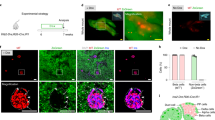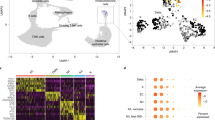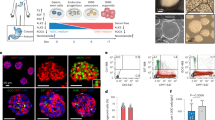Key Points
-
The pancreas is a complex organ that consists of two parts: exocrine, which secretes digestive enzymes into the gut; and endocrine, which secretes the four hormones insulin, glucagon, somatostatin and pancreatic polypeptide.
-
Early studies showed that initial stages of pancreatic development depend on epithelio-mesenchymal interactions, and members of the fibroblast growth factor and epidermal growth factor families of signalling factors were subsequently shown to be part of the signal from the mesenchyme.
-
Mesenchyme has a permissive rather than an instructive role in pancreatic induction.
-
Due to its proximity to the dorsal endoderm, the notochord has been the prime candidate for directing pancreatic development. Although initial in vitro experiments confirmed this prediction, according to more recent studies, the notochord's role is only permissive.
-
Pancreatic growth and differentiation is also affected by Notch signalling — it controls the choice between differentiated endocrine and progenitor cells.
-
Because of neuronal-marker expression, pancreatic endocrine cells were originally proposed to be of neuronal origin. It has now been unequivocally established that they arise from the endoderm.
-
An important note of caution emerges from these studies — a great deal of care is required when cell populations are characterized on the basis of expression markers. Efforts to identify pancreatic stem cells with the aim to treat diabetic patients using cell-replacement therapy might be hampered by the erroneous choice of markers to define pancreatic stem-cell populations.
Abstract
The pancreas is a mixed exocrine and endocrine gland that controls many homeostatic functions. The exocrine pancreas produces and secretes digestive enzymes, whereas the endocrine compartment consists of four distinct hormone-producing cell types. Studies that further our knowledge of the basic mechanisms that underlie the formation of the pancreas will be crucial for understanding the development and homeostasis of this organ and of the mechanisms that cause diabetes. This information is also pivotal for any attempt to generate functional insulin-producing β-cells that are suitable for transplantation.
This is a preview of subscription content, access via your institution
Access options
Subscribe to this journal
Receive 12 print issues and online access
$189.00 per year
only $15.75 per issue
Buy this article
- Purchase on Springer Link
- Instant access to full article PDF
Prices may be subject to local taxes which are calculated during checkout





Similar content being viewed by others
References
Wessels, N. K. & Cohen, J. H. Early pancreas organogenesis: morphogenesis, tissue interactions and mass effects. Dev. Biol. 15, 237–270 (1967).A detailed analysis of the specification of pancreas, early pancreatic development and the influence of neighbouring tissues such as the mesenchyme. It includes beautiful and informative pictures of the formation of the pancreatic buds.
Pictet, R. & Rutter, W. J. in Handbook of Physiology (eds Steiner, D. F. & Frenkel, N.) 25–66 (Williams & Wilkins, Washington DC, 1972).
Edlund, H. Transcribing pancreas. Diabetes 47, 1817–1823 (1998).
Edlund, H. Pancreas: how to get there from the gut? Curr. Opin. Cell Biol. 11, 663–668 (1999).
Sander, M. & German, M. S. The β cell transcription factors and the development of the pancreas. J. Mol. Med. 75, 327–340 (1997).
St-Ogne, L., Wehr, R. & Gruss, P. Pancreas development and diabetes. Curr. Opin. Genet. Dev. 9, 295–300 (1999).
Shapiro, A. M. et al. Islet transplantation in seven patients with type 1 diabetes mellitus using a glucocorticoid-free immunosuppressive regimen. N. Engl. J. Med. 343, 230–238 (2000).
Jonsson, J., Carlsson, L., Edlund, T. & Edlund, H. Insulin-promoter-factor 1 is required for pancreas development in mice. Nature 371, 606–609 (1994).
Offield, M. F. et al. PDX-1 is required for pancreatic outgrowth and differentiation of the rostral duodenum. Development 122, 983–995 (1996).
Ahlgren, U., Jonsson, J. & Edlund, H. The morphogenesis of the pancreatic mesenchyme is uncoupled from that of the pancreatic epithelium in PDX1/IPF1-deficient mice. Development 122, 1409–1416 (1996).
Ahlgren, U., Jonsson, J., Jonsson, L., Simu, K. & Edlund, H. β-cell-specific inactivation of the mouse Ipf1/Pdx1 gene results in loss of the β-cell phenotype and maturity onset diabetes. Genes Dev. 12, 1763–1768 (1998).
Li, H., Arber, S., Jessell, T. M. & Edlund, H. Selective agenesis of the dorsal pancreas in mice lacking homeobox gene Hlxb9. Nature Genet. 23, 67–70 (1999).
Harrison, K. A., Thaler, J., Pfaff, S. L., Gu, H. & Kehrl, J. H. Pancreas dorsal lobe agenesis and abnormal islets of Langerhans in Hlxb9-deficient mice. Nature Genet. 23, 71–75 (1999).References 12 and 13 describe the role of Hlxb9 during pancreas development. Like Ipf1/Pdx1, Hlxb9 is transiently expressed in the early pancreatic buds, and later in development its expression becomes restricted to differentiated β-cells. This study shows that Hlxb9 is required for the initiation of the dorsal pancreatic programme and for ensuring proper endocrine-cell differentiation in the ventral bud.
Sussel, L. et al. Mice lacking the homeodomain transcription factor Nkx2.2 have diabetes due to arrested differentiation of pancreatic β cells. Development 125, 2213–2221 (1998).
Sander, M. et al. Homeobox gene Nkx6.1 lies downstream of Nkx2.2 in the major pathway of β-cell formation in the pancreas. Development 127, 5533–5540 (2000).
Ahlgren, U., Pfaff, S., Jessel, T. M., Edlund, T. & Edlund, H. Independent requirement for ISL1 in the formation of the pancreatic mesenchyme and islet cells. Nature 385, 257–260 (1997).
Sosa-Pineda, B., Chowdhury, K., Torres, M., Oliver, G. & Gruss, P. The Pax4 gene is essential for differentiation of insulin-producing β cells in the mammalian pancreas. Nature 386, 399–402 (1997).
Sander, M. et al. Genetic analysis reveals that PAX6 is required for normal transcription of pancreatic hormone genes and islet development. Genes Dev. 11, 1662–1673 (1997).
St-Onge, L., Sosa-Pineda, B., Chowdhury, K., Mansouri, A. & Gruss, P. Pax6 is required for differentiation of glucagon-producing α-cells in mouse pancreas. Nature 387, 406–409 (1997).
Naya, F. J. et al. Diabetes, defective pancreatic morphogenesis, and abnormal enteroendocrine differentiation in BETA2/neuroD-deficient mice. Genes Dev. 11, 2323–2334 (1997).
Gradwohl, G., Dierich, A., LeMeur, M. & Guillemot, F. Neurogenin3 is required for the development of the four endocrine cell lineages of the pancreas. Proc. Natl Acad. Sci. USA 97, 1607–1611 (2000).
Krapp, A. et al. The bHLH protein PTF1-p48 is essential for the formation of the exocrine and the correct spatial organization of the endocrine pancreas. Genes Dev. 12, 3752–3763 (1998).The authors describe a targeted inactivation of the exocrine transcription factor p48, which is the first gene to be described that selectively impairs exocrine pancreatic development. This paper also provides genetic evidence that islet-cell differentiation, but not organization, is independent of exocrine-cell differentiation.
Pin, C. L., Rukstalis, J. M., Johnson, C. & Konieczny, S. F. The bHLH transcription factor Mist1 is required to maintain exocrine pancreas cell organization and acinar cell identity. J. Cell Biol. 155, 519–530 (2001).
Boj, S. F., Parrizas. M., Maestro, M. A. & Ferrer, J. A transcription factor regulatory circuit in differentiated pancreatic cells. Proc. Natl Acad. Sci. USA 98, 14481–14486 (2001).
Dukes, I. D. et al. Defective pancreatic β-cell glycolytic signaling in hepatocyte nuclear factor-1α-deficient mice. J. Biol. Chem. 273, 24457–24464 (1998).
Kaestner, K. H., Katz, J., Liu, Y., Drucker, D. J. & Schutz, G. Inactivation of the winged helix transcription factor HNF3α affects glucose homeostasis and islet glucagon gene expression in vivo. Genes Dev. 13, 495–504 (1999).
Shih, D. Q., Navas, M. A., Kuwajima, S., Duncan, S. A. & Stoffel, M. Impaired glucose homeostasis and neonatal mortality in hepatocyte nuclear factor 3α-deficient mice. Proc. Natl Acad. Sci. USA 96, 10152–10157 (1999).
Sund, N. J. et al. Tissue-specific deletion of Foxa2 in pancreatic β cells results in hyperinsulinemic hypoglycemia. Genes Dev. 15, 1706–1715 (2001).
Rausa, F. et al. The cut-homeodomain transcriptional activator HNF-6 is coexpressed with its target gene HNF-3β in the developing murine liver and pancreas. Dev. Biol. 192, 228–246 (1997).
Landry, C. et al. HNF-6 is expressed in endoderm derivatives and nervous system of the mouse embryo and participates to the cross-regulatory network of liver-enriched transcription factors. Dev. Biol. 192, 247–257 (1997).
Jacquemin, P. et al. Transcription factor hepatocyte nuclear factor 6 regulates pancreatic endocrine cell differentiation and controls expression of the proendocrine gene ngn3. Mol. Cell. Biol. 20, 4445–4454 (2000).
Golosow, N. & Grobstein, C. Epitheliomesenchymal interaction in pancreatic morphogenesis. Dev. Biol. 4, 242–255 (1962).
Miettinen, P. J. et al. Impaired migration and delayed differentiation of pancreatic islet cells in mice lacking EGF-receptors. Development 127, 2617–2627 (2000).
Erickson, S. L. et al. ErbB3 is required for normal cerebellar and cardiac development: a comparison with ErbB2- and heregulin-deficient mice. Development 124, 4999–5011 (1997).
Cras-Meneur, C., Elghazi, L., Czernichow, P. & Scharfmann, R. Epidermal growth factor increases undifferentiated pancreatic embryonic cells in vitro: a balance between proliferation and differentiation. Diabetes 50, 1571–1579 (2001).
Kato, S. & Sekine, K. FGF–FGFR signaling in vertebrate organogenesis. Cell. Mol. Biol. 45, 631–638 (1999).
Szebenyi, G. & Fallon, J. F. Fibroblast growth factors as multifunctional signaling factors. Int. Rev. Cytol. 185, 45–106 (1999).
Le Bras, S., Miralles, F., Basmaciogullari, A., Czernichow, P. & Scharfmann, R. Fibroblast growth factor 2 promotes pancreatic epithelial cell proliferation via functional fibroblast growth factor receptors during embryonic life. Diabetes 47, 1236–1242 (1998).
Miralles, F., Czernichow, P., Ozaki, K., Itoh, N. & Scharfmann, R. Signaling through fibroblast growth factor receptor 2b plays a key role in the development of the exocrine pancreas. Proc. Natl Acad. Sci. USA 96, 6267–6272 (1999).
Celli, G., LaRochelle, W. J., Mackem, S., Sharp, R. & Merlino, G. Soluble dominant-negative receptor uncovers essential roles for fibroblast growth factors in multi-organ induction and patterning. EMBO J. 17, 1642–1655 (1998).
Ohuchi, H. et al. FGF10 acts as a major ligand for FGF receptor 2 IIIb in mouse multi-organ development. Biochem. Biophys. Res. Commun. 277, 643–649 (2000).
Bhushan, A. et al. Fgf10 is essential for maintaining the proliferative capacity of epithelial progenitor cells during early pancreatic organogenesis. Development 128, 5109–5117 (2001).References 38–42 show that FGF signalling stimulates pancreatic epithelial proliferation and exocrine differentiation, and that FGFR2b/FGF10 signalling is required for pancreatic epithelial-cell expansion.
Hart, A. W., Baeza, N., Apelqvist, Å. & Edlund, H. Attenuation of FGF-signalling in mouse β-cells leads to diabetes. Nature 408, 864–868 (2000).The authors show that the requirement for Fgfr1c- signalling in adult β-cells for maintenance of β-cell function is downstream of Ipf1/Pdx1 function. Reference 47 provides a model of Fgfr1c signalling in adult β-cells.
Otonkoski, T. et al. A role for hepatocyte growth factor/scatter factor in fetal mesenchyme-induced pancreatic β-cell growth. Endocrinology 137, 3131–3139 (1996).
Miralles, F., Philippe, P., Czernichow, P. & Scharfmann, R. Expression of nerve growth factor and its high-affinity receptor Trk-A in the rat pancreas during embryonic and fetal life. J. Endocrinol. 156, 431–439 (1998).
Lammert, E., Cleaver, O., & Melton, D. Induction of pancreatic differentiation by signals from blood vessels. Science 294, 564–567 (2001).This paper highlights the stimulatory effect of endothelial cells in pancreatic islet-cell generation and proposes a role for VEGF in this process.
Edlund, H. Factors controlling pancreatic cell differentiation and function. Diabetologia 44, 1071–1079 (2001).
Apelqvist, Å. et al. Notch-signalling controls pancreatic cell differentiation. Nature 400, 877–881 (1999).
Jensen, J. et al. Control of endodermal endocrine development by Hes-1. Nature Genet. 24, 36–44 (2000).References 21, 48 and 49 provide evidence that, analogous to its role in the nervous system, Notch signalling controls cell differentiation in the pancreas and that ngn3 functions as a pro-endocrine gene. Therefore, in the developing pancreas, Notch signalling seems to control the choice between endocrine and exocrine fates, so that a lack of this signalling results in high expression levels of ngn3 , promoting the endocrine fate (cells with active Notch signalling adopt the exocrine fate). Absence of ngn3 function results in a selective loss of all pancreatic endocrine cells, confirming the role of ngn3.
Kim, S. K., Hebrok, M. & Melton, D. A. Notochord to endoderm signalling is required for pancreas development. Development 124, 4243–4252 (1997).
Hebrok, M., Kim, S. K. & Melton, D. A. Notochord repression of endodermal Sonic hedgehog permits pancreas development. Genes Dev. 12, 1705–1713 (1998).
Deutsch, G., Jung, J., Zheng, M., Lora, J. & Zaret, K. S. A bipotential precursor population for pancreas and liver within the embryonic endoderm. Development 128, 871–881 (2001).
Pearse, A. G. E. Islet cell precursors are neurones. Nature 295, 96–97 (1982).
Le Douarin, N. M. On the origin of pancreatic endocrine cells. Cell 53, 169–171 (1988).
Pictet, R. L., Rall, L. B., Phelps, P. & Rutter, W. J. The neural crest and the origin of the insulin-producing and other gastrointestinal hormone producing cells. Science 191, 191–192 (1976).
Fontaine, J. & Le Douarin, N. M. Analysis of endoderm formation in the avian blastoderm by the use of quail–chick chimaeras. The problem of the neurectodermal origin of the cells of the APUD series. J. Embryol. Exp. Morphol. 41, 209–222 (1977).
Lendahl, U., Zimmerman, L. B. & McKay, R. D. CNS stem cells express a new class of intermediate filament protein. Cell 23, 585–595 (1990).
Hunziker, E. & Stein, M. Nestin-expressing cells in the pancreatic islets of Langerhans. Biochem. Biophys. Res. Commun. 271, 116–119 (2000).
Zulewski, H. et al. Multipotential nestin-positive stem cells isolated from adult pancreatic islets differentiate ex vivo into pancreatic endocrine, exocrine, and hepatic phenotypes. Diabetes 50, 521–533 (2001).
Lumelsky, N. et al. Differentiation of embryonic stem cells to insulin-secreting structures similar to pancreatic islets. Science 292, 1389–1394 (2000).
Lee, S. H., Lumelsky, N., Studer, L., Auerbach, J. M. & McKay, R. D. Efficient generation of midbrain and hindbrain neurons from mouse embryonic stem cells. Nature Biotechnol. 18, 675–679 (2000).
Alpert, S., Hanahan, D. & Teitelman, G. Hybrid insulin genes reveal a developmental lineage for pancreatic endocrine cells and imply a relationship with neurons. Cell 53, 295–308 (1988).
Nakamura, T. et al. Insulin production in a neuroectodermal tumor that expresses islet factor-1, but not pancreatic-duodenal homeobox 1. J. Clin. Endocrinol. Metab. 86, 1795–1800 (2001).
Assady, S. et al. Insulin production by human embryonic stem cells. Diabetes 50, 1691–1697 (2001).
Soria, B. et al. Insulin-secreting cells derived from embryonic stem cells normalize glycemia in streptozotocin-induced diabetic mice. Diabetes 49, 157–162 (2000).
Selander, L. & Edlund, H. Nestin is expressed in mesenchymal and not epithelial cells of the developing mouse pancreas. Mech. Dev. 113, 189–192 (2002).The authors show that the intermediate filament protein nestin is expressed in mesenchymal cells of the gastrointestinal tract, including the pancreas, and not in pancreatic progenitor cells, nor in differentiated pancreatic cell types.
Githens, S. The pancreatic duct cell: proliferative capabilities, specific characteristics, metaplasia, isolation, and culture. J. Pediatr. Gastroenterol. Nutr. 7, 486–506 (1988).
Rosenberg, L. In vivo cell transformation: neogenesis of β cells from pancreatic ductal cells. Cell Transplant. 4, 371–383 (1995).
Bouwens, L. Transdifferentiation versus stem cell hypothesis for the regeneration of islet β-cells in the pancreas. Microsc. Res. Tech. 43, 332–336 (1998).
Stoffers, D. A., Ferrer, J., Clarke, W. L. &. Habener, J. F. Early-onset type-II diabetes mellitus (MODY4) linked to IPF1. Nature Genet. 17, 138–139 (1997).
Hattersley, A. T. Maturity-onset diabetes of the young: clinical heterogeneity explained by genetic heterogeneity. Diabetes Med. 15, 15–24 (1998).
Malecki, M. T. et al. Mutations in NEUROD1 are associated with the development of type 2 diabetes mellitus. Nature Genet. 23, 323–328 (1999).
Slack, J. M. Developmental biology of the pancreas. Development 121, 1569–1580 (1995).
Acknowledgements
Work in my laboratories is supported by the Juvenile Diabetes Research Foundation, New York, the Swedish Research Council, the European Commission, The Göran Gustafsson's Foundation, the Wallenberg Foundation and The Diabetes Research Foundation, Miami. I wish to thank T. Edlund, for critical reading and helpful comments, U. Ahlgren for help with figures, and members of the laboratories at Umeå University, Umeå, Sweden, and the Diabetes Research Institute, University of Miami, USA, for discussions.
Author information
Authors and Affiliations
Related links
Related links
DATABASES
Flybase
LocusLink
OMIM
Glossary
- ACINAR CELLS
-
A group of secretory cells surrounding a cavity; in the pancreas, they secrete pancreatic enzymes such as α-amylase or chymotrypsinogen.
- ZYMOGEN
-
An inactive enzyme precursor that is chemically altered by hydrolysis to the active form of the enzyme.
- ANLAGEN
-
A precursor tissue before its determination and differentiation.
- CATECHOLAMINE
-
The neurotransmitters dopamine, norepinephrine and epinephrine.
- EMBRYOID BODIES
-
Clumps or cellular structures that arise when embryonic cells are cultured in vitro; they contain tissues from all three germ layers: endoderm, mesoderm and ectoderm.
- CELL-TRAPPING EXPERIMENTS
-
A technique for the selective isolation of cells on the basis of expression of selectable markers that are expressed from a promoter that is specific to the given cell type.
- DUODENUM
-
The first part of the small intestine, immediately posterior to the stomach.
- GASTRIC PYLORIC ANTRUM
-
The most posterior part of the stomach, immediately anterior to the small intestine.
Rights and permissions
About this article
Cite this article
Edlund, H. Pancreatic organogenesis — developmental mechanisms and implications for therapy. Nat Rev Genet 3, 524–532 (2002). https://doi.org/10.1038/nrg841
Issue Date:
DOI: https://doi.org/10.1038/nrg841
This article is cited by
-
Talin-1 inhibits Smurf1-mediated Stat3 degradation to modulate β-cell proliferation and mass in mice
Cell Death & Disease (2023)
-
Proteogenomic insights into the biology and treatment of pancreatic ductal adenocarcinoma
Journal of Hematology & Oncology (2022)
-
Stem cells differentiation into insulin-producing cells (IPCs): recent advances and current challenges
Stem Cell Research & Therapy (2022)
-
Transcriptomic study of anastasis for reversal of ethanol-induced apoptosis in mouse primary liver cells
Scientific Data (2022)
-
Exploring the effect of epigenetic modifiers on developing insulin-secreting cells
Human Cell (2020)



